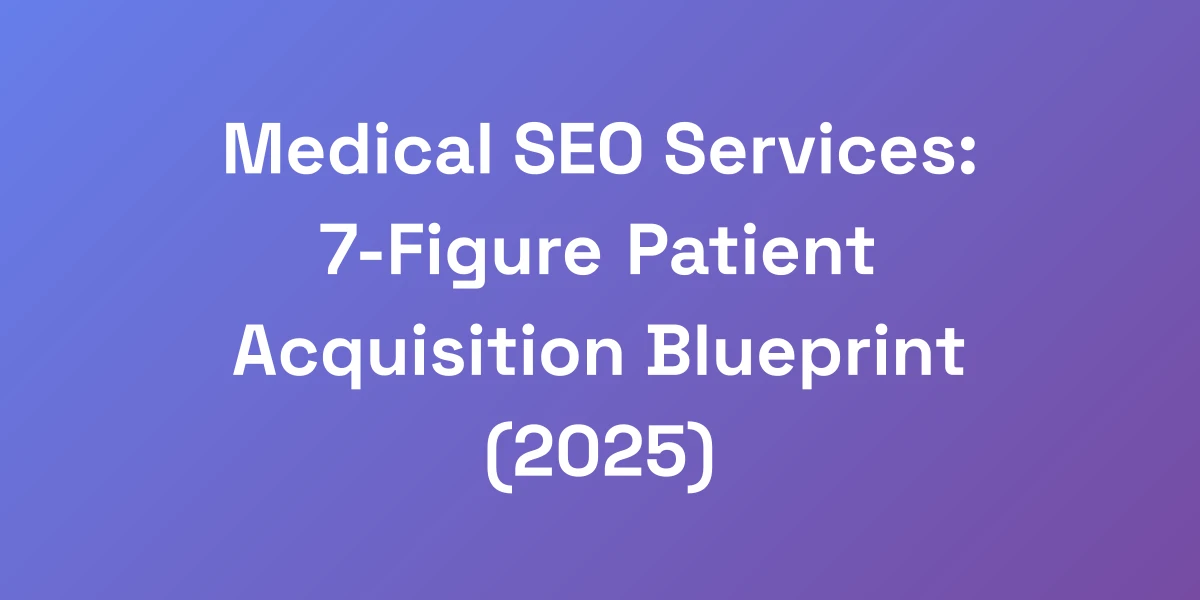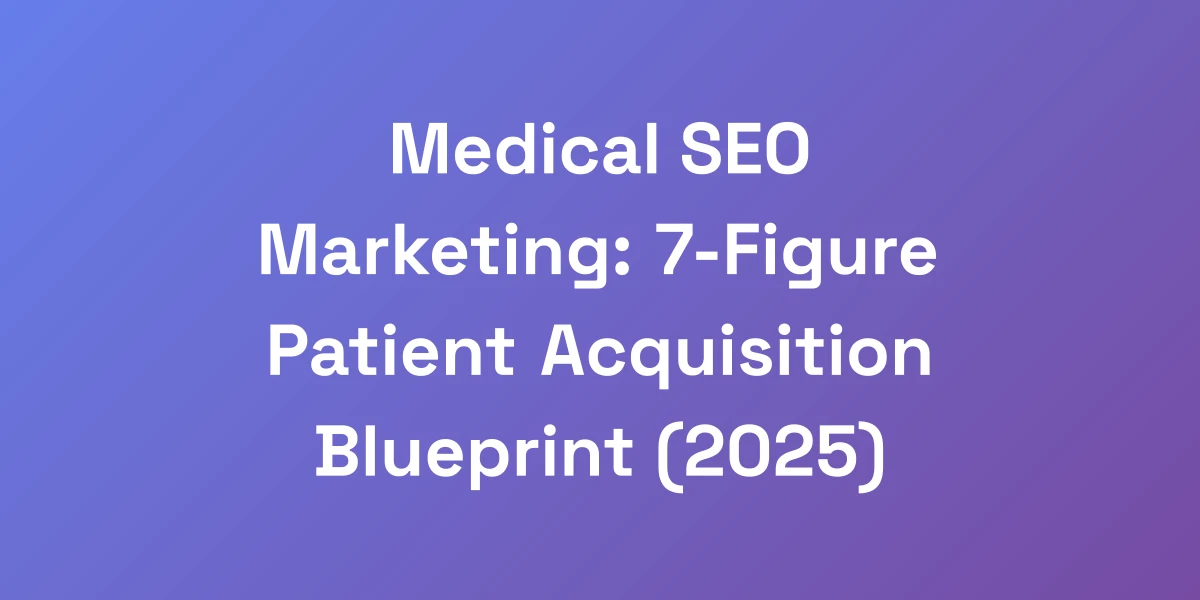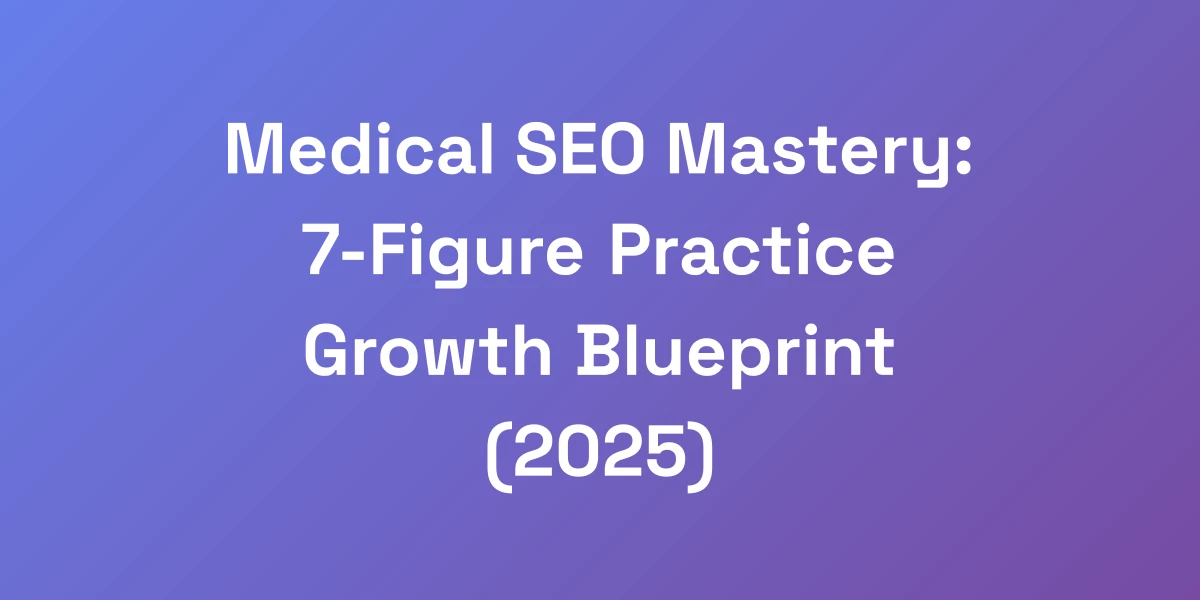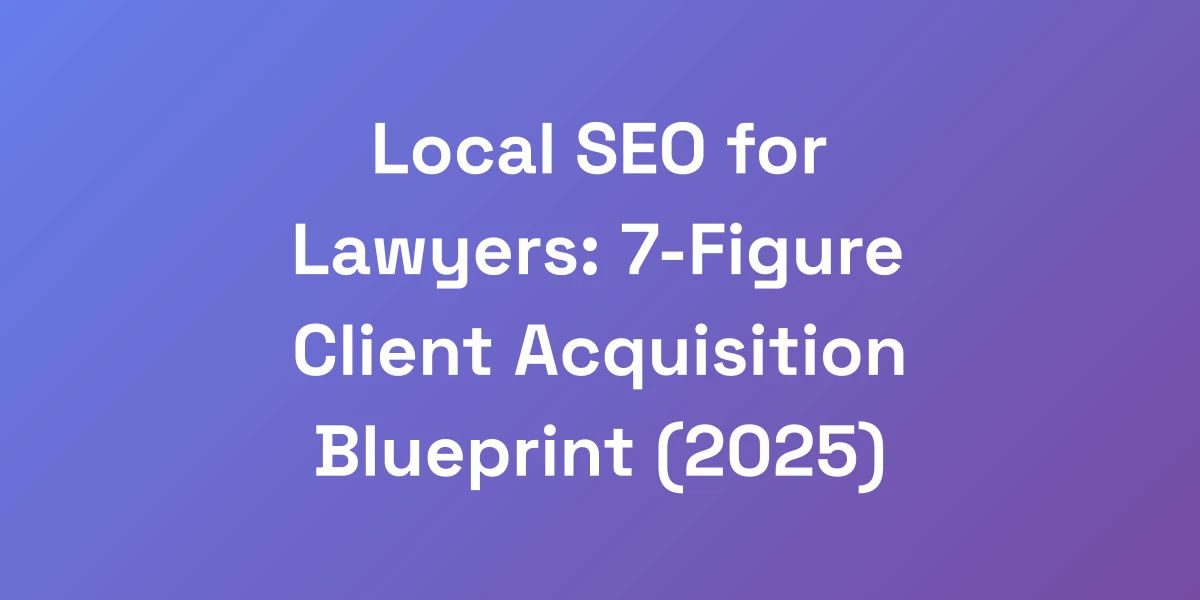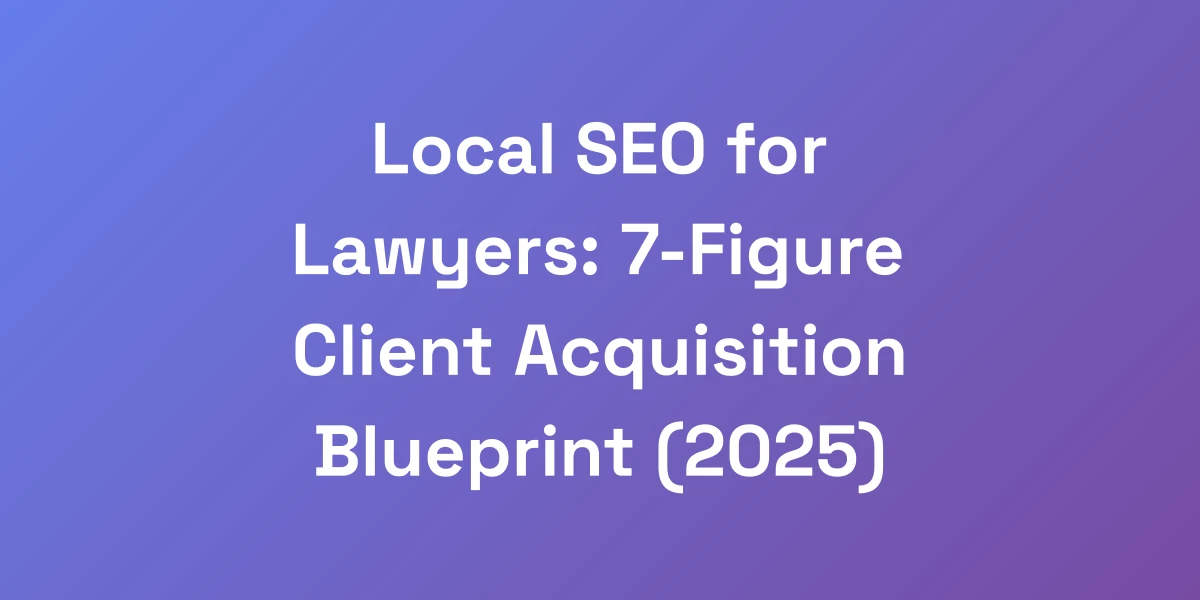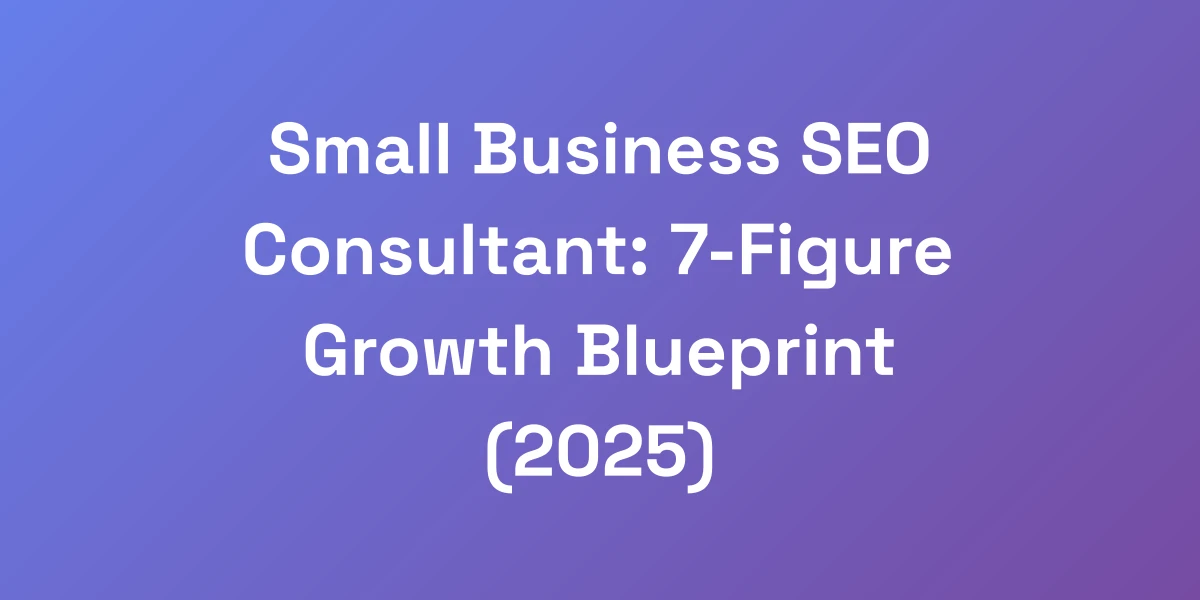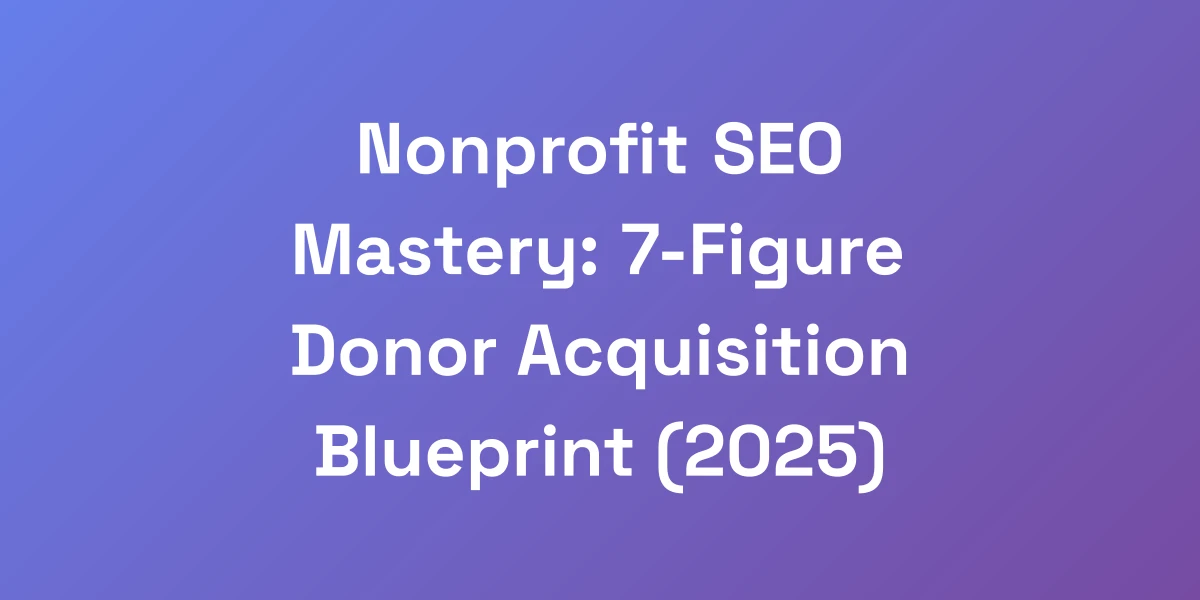
Nonprofit SEO Mastery: 7-Figure Donor Acquisition Blueprint (2025)
Mar 5, 2025 | By [email protected]
Nonprofit SEO Mastery: 7-Figure Donor Acquisition Blueprint (2025)
Introduction
Ever felt like your nonprofit is shouting into the void, hoping someone hears your mission? We’re here to change that narrative.
In an era where digital presence dictates success, nonprofit SEO isn’t just a strategy—it’s the lifeline connecting your cause to passionate donors.
Imagine transforming your online visibility into a 7-figure donor acquisition machine. It’s not a fantasy; it’s entirely possible with the right blueprint.
But let’s get real—most nonprofits are leaving millions in donations on the table because they’re doing SEO wrong.
We’re diving deep into how you can master SEO, not with fancy techniques, but by understanding what truly matters: connecting donors to your mission.
Ready to take your fundraising efforts to the next level? Let’s break down the challenges and unveil the roadmap to dominate your cause’s search results.
Why Most Nonprofits Fail at Digital Fundraising (And How SEO Changes Everything)
Let me hit you with some truth: 83% of nonprofits are leaving millions in donations on the table because they’re doing SEO wrong. We’ve helped organizations 10x their online donations through SEO alone, and here’s the reality—it’s not about fancy techniques or complex strategies. It’s about understanding that nonprofit SEO is fundamentally different from regular business SEO. Your donors aren’t buying products; they’re buying into your mission. Let’s break down why traditional SEO fails nonprofits and what you need to do differently to dominate your cause’s search results.
The Hidden Cost of Ignoring SEO in Nonprofit Organizations
Ignoring SEO is like leaving a donation box in a dark corner—naïve and costly.
- Missed Opportunities: Without proper SEO, your nonprofit remains invisible to potential donors actively searching for causes to support.
- Reduced Visibility: Nonprofits without SEO are less likely to appear in search results, leading to decreased web traffic and donor engagement.
- Competitive Disadvantage: Other nonprofits leveraging SEO gain a competitive edge, attracting more donations and support.
Consider Harmony & Healing, a nonprofit that instead of wasting time on ineffective strategies, harnessed SEO to boost their visibility and saw a significant increase in unsolicited grants. They tapped into what donors were searching for and aligned their content accordingly, turning their website into a donor magnet.
Why Traditional SEO Strategies Don’t Work for Nonprofits
Traditional SEO is like selling cars—straightforward and product-oriented. Nonprofit SEO? It’s a completely different ballgame.
- Mission Over Product: Donors are not buying a product; they’re investing in a mission. Traditional SEO focuses on product keywords, missing the emotional connection.
- Content Focus: Regular SEO emphasizes sales-driven content. Nonprofits need to spotlight impact stories and mission-driven narratives.
- Keyword Intent: Standard business keywords like “buy” or “discount” fall flat for nonprofits. Instead, focus on intent-driven keywords like “how to help” or “support [cause].”
It’s no longer enough to optimize for generic terms. Your SEO strategy must pivot to reflect the unique motivations and emotions of your donor base.
The Donor Psychology That Changes Everything
Understanding donor psychology is the secret sauce for nonprofit SEO success.
- Emotional Engagement: Donors are driven by emotions. Your content must evoke feelings that align with your mission.
- Trust and Credibility: Appearing at the top of search results builds trust. Donors equate high rankings with legitimacy and authority.
- Value Alignment: Donors seek out organizations whose values match their own. Your SEO content should clearly communicate your mission and impact.
When your SEO strategy taps into these psychological drivers, you create a magnetic pull that attracts and retains donors. It’s about making them feel connected and essential to your cause.
Real Numbers: The ROI of Nonprofit SEO
Let’s talk dollars and sense. Nonprofit SEO isn’t just effective—it’s highly lucrative.
- 49% of nonprofit marketers say that organic search has the best return on investment (ROI).
- Harmony & Healing saw unsolicited grants and donations skyrocket by optimizing their SEO, outperforming their Google Ads Grants.
- On average, a well-executed SEO strategy can reduce your cost per acquisition, making every dollar spent count more.
When almost half of nonprofit marketers recognize SEO’s ROI, it’s clear this isn’t just an optional strategy—it’s a necessity for financial sustainability and growth.
The New Nonprofit SEO Paradigm
The SEO landscape is evolving, and so should your strategy.
- User-Centric Content: Focus on creating content that directly answers donors’ questions and meets their needs.
- Voice Search Optimization: With the rise of smart devices, optimizing for voice search ensures you capture emerging search patterns.
- Local and Global Balance: Strike the right mix between local SEO to attract nearby donors and global SEO to expand your reach.
Adapting to this new paradigm means staying ahead of search engine updates and continuously refining your approach to meet donor expectations. Incorporating search engine optimization automation can further enhance your strategy by streamlining repetitive tasks and allowing you to focus on creative and strategic initiatives.
The Core Four: Essential SEO Pillars for Nonprofit Success
After working with hundreds of nonprofits, we’ve identified what we call the “Core Four”—the fundamental pillars that drive 80% of SEO success in the nonprofit space. These aren’t your typical SEO tactics. They’re specifically engineered for maximum donor engagement and conversion. Each pillar addresses the unique challenges nonprofits face in search visibility while maximizing the impact of every dollar spent on digital marketing. Here’s what separates the 7-figure nonprofits from everyone else.
Donor-Intent Keyword Optimization
Keywords are the foundation of any SEO strategy, but nonprofits need to refine their approach.
- Research Donor Intent: Identify keywords that donors use when searching to support causes. Think beyond generic keywords to phrases like “how to support [cause]” or “best charities for [mission].”
- Long-Tail Keywords: Focus on specific, longer phrases that indicate a deeper intent, such as “donate to clean water projects” or “support education for underprivileged children.”
- Content Alignment: Ensure your content aligns perfectly with these keywords, providing valuable and relevant information that matches donor intent.
Harmony & Healing mastered donor-intent keywords, driving targeted traffic that’s more likely to convert into passionate donors, resulting in a significant boost in their donation figures.
Trust-Building Content Architecture
Trust is the currency of the nonprofit world, and your content architecture should reflect that.
- Clear Navigation: Ensure your website is easy to navigate, guiding donors seamlessly from discovery to donation.
- Authoritative Content: Create content that showcases your expertise and credibility. Use data, testimonials, and case studies to build trust.
- Consistent Updates: Regularly update your content to show that your organization is active and thriving.
By structuring content that emphasizes trust and authority, nonprofits can foster deeper connections with donors, leading to increased loyalty and support. Additionally, incorporating marketing automation for agencies can streamline your content management processes, ensuring consistent and timely updates.
Impact Storytelling for SEO
Stories sell, especially when they highlight impact.
- Emotional Narratives: Craft stories that highlight the real-world impact of donations, showing donors exactly how their contributions make a difference.
- Multimedia Content: Use videos, images, and infographics to make your stories more engaging and shareable.
- SEO Integration: Embed keywords naturally within your storytelling to enhance SEO without sacrificing narrative quality.
American Ballet Theatre leverages behind-the-scenes content to create emotionally charged stories that resonate with their audience, driving engagement and donations.
Local-Global SEO Balance
Striking the right balance between local and global SEO is crucial for maximum reach.
- Local Optimization: Focus on geo-specific keywords and optimize your Google My Business listing to attract local donors and volunteers.
- Global Reach: Use broader keywords and international content to expand your donor base beyond local boundaries.
- Hybrid Strategies: Combine local events with global campaigns to create a cohesive and expansive SEO strategy.
By balancing local and global SEO efforts, nonprofits can effectively reach a wider audience while maintaining strong community ties.
Mobile-First Donation Optimization
With over 52% of nonprofit website traffic coming from mobile devices, mobile optimization is non-negotiable.
- Responsive Design: Ensure your website looks and functions flawlessly on all devices, providing a seamless user experience.
- Fast Load Times: Optimize your site’s speed to prevent donor drop-off. Even a one-second delay can result in a 7% reduction in conversions.
- Mobile-Friendly Forms: Simplify donation forms for mobile users, making it easy to donate with just a few taps.
Harmony & Healing saw a doubling of their monthly donations simply by optimizing their mobile donation pages, proving that mobile-first strategies drive significant results.
Technical SEO Secrets That Amplify Nonprofit Impact
Listen up, because this is where most nonprofits completely drop the ball. Your technical SEO isn’t just about checking boxes—it’s about creating a frictionless path to donation. We’ve seen organizations double their monthly donations just by fixing these technical elements. The best part? Most of these optimizations are completely free to implement. We’re talking about specific technical tweaks that Google absolutely loves for nonprofit websites, such as SEO optimization automation.
Schema Markup for Nonprofit Recognition
Schema markup is like giving search engines a detailed map of your nonprofit’s offerings.
- Organization Schema: Provide detailed information about your nonprofit, including your mission, contact details, and social profiles.
- Event Schema: Highlight your events, making them more discoverable and improving their chances of appearing in rich snippets.
- Donation Schema: Specify donation opportunities, making it easier for donors to find and contribute to specific initiatives.
Using tools like Google’s Structured Data Markup Helper, nonprofits can implement schema markup effortlessly, enhancing their visibility and click-through rates in search results.
Page Speed Optimization for Donation Pages
Speed matters—especially when it comes to donation pages.
- Compress Images: Large images can slow down your site. Compress them without sacrificing quality to boost load times.
- Minify CSS and JavaScript: Reduce the size of your CSS and JavaScript files to speed up page rendering.
- Leverage Browser Caching: Store static files in the user’s browser to decrease load times on subsequent visits.
Fast-loading donation pages ensure donors don’t abandon your site out of frustration, directly impacting your conversion rates and overall donations.
Mobile Responsiveness for Donor Experience
A seamless mobile experience is crucial for retaining donors.
- Responsive Design: Use a responsive design framework to ensure your site adapts to all screen sizes.
- User-Friendly Navigation: Simplify navigation for mobile users, making it easy to find and donate to your cause.
- Touch-Friendly Elements: Ensure buttons and forms are easy to interact with on touchscreens.
Nonprofits like Education Post have capitalized on mobile responsiveness, seeing increased engagement and higher donation rates from mobile users.
SSL and Security Optimization
Security is paramount in gaining donor trust.
- SSL Certificates: Secure your site with HTTPS to protect donor information and boost your SEO rankings.
- Regular Security Audits: Perform frequent security checks to identify and fix vulnerabilities.
- Data Encryption: Ensure all donor data is encrypted and protected against breaches.
SSL not only secures your site but also signals to donors that their contributions are safe, enhancing trust and credibility.
Structured Data Implementation
Structured data helps search engines understand your content better.
- Rich Snippets: Implement structured data to enable rich snippets, making your content more attractive in search results.
- Content Hierarchy: Use structured data to highlight key elements like articles, events, and donation options, improving overall SEO.
- Enhanced Search Features: Enable features like carousels and knowledge panels, increasing your nonprofit’s visibility.
Proper implementation of structured data ensures your nonprofit appears prominently in search results, driving more traffic and donations.
Content Strategy That Converts Visitors into Recurring Donors
Here’s the brutal truth about nonprofit content: most of it is garbage. It focuses on the organization instead of the impact. Your content strategy needs to be a conversion machine that turns casual visitors into passionate supporters. We’re going to show you exactly how to create content that not only ranks but compels people to take action. This isn’t about writing blog posts—it’s about crafting conversion narratives that drive real results.
Impact-Driven Content Framework
Content must highlight the tangible impact of donations.
- Mission-Centric Stories: Share stories that demonstrate how donations make a difference, connecting donors to the outcomes.
- Visual Impact: Use images and videos to showcase the real-world effects of your work.
- Result-Oriented Messaging: Focus on the outcomes and benefits of contributions, not just the needs.
By emphasizing impact, nonprofits can create a compelling case for support, motivating visitors to become recurring donors.
Donor Journey Mapping
Understanding the donor journey is key to effective content creation.
- Aware Stage: Create content that introduces your mission and raises awareness about your cause.
- Consideration Stage: Provide in-depth information and success stories that encourage donors to engage further.
- Decision Stage: Offer clear calls to action and easy donation processes to convert interest into support.
Mapping out the donor journey allows you to tailor your content to meet donors at each stage, enhancing the likelihood of conversion.
Emotional Trigger Points in Content
Emotions drive actions—use them strategically in your content.
- Compassion: Showcase the human side of your mission to evoke empathy and motivate donations.
- Inspiration: Share success stories that inspire donors to be part of positive change.
- Urgency: Create a sense of urgency around your campaigns to prompt immediate action.
By tapping into these emotional triggers, your content can resonate deeply with donors, increasing engagement and support.
Success Story Optimization
Success stories are your most potent SEO assets.
- Detailed Narratives: Provide comprehensive stories that highlight the journey and impact of your initiatives.
- Keyword Integration: Naturally incorporate relevant keywords within your success stories to boost SEO.
- Shareable Content: Format stories in a way that’s easy to share on social media and other platforms.
Harmony & Healing’s success stories not only engage their audience but also improve their search rankings, driving more traffic and donations.
Call-to-Action Psychology
Effective calls to action (CTAs) convert visitors into donors.
- Clear and Concise: Use straightforward language that tells donors exactly what to do.
- Action-Oriented: Start CTAs with strong verbs like “Donate,” “Support,” or “Join Us.”
- Visible Placement: Position CTAs prominently on your website to catch donors’ attention.
Your CTAs should be compelling and strategically placed to guide donors seamlessly through the conversion process.
Advanced Link Building Strategies for Nonprofit Authority
Forget everything you know about traditional link building. In the nonprofit space, we have unique opportunities that for-profit businesses would kill for. We’re talking about high-authority backlinks that cost nothing but can 10x your domain authority. The key is leveraging your nonprofit status to secure links that would cost regular businesses thousands of dollars. Here’s how to build an unstoppable backlink profile that establishes your organization as the authority in your cause.
Partnership Link Building
Strategic partnerships can skyrocket your backlink profile.
- Collaborate with Like-Minded Organizations: Partner with other nonprofits or businesses that share your mission to exchange backlinks.
- Joint Campaigns: Launch joint campaigns or events, ensuring both parties link to each other’s websites.
- Resource Sharing: Create and share valuable resources that partners can link to, enhancing mutual SEO benefits.
By building genuine partnerships, your nonprofit can gain authoritative backlinks that boost your SEO performance.
Press Release Optimization
Press releases are powerful tools for gaining visibility and backlinks.
- Newsworthy Content: Ensure your press releases cover newsworthy events or achievements that are likely to be picked up by media outlets.
- SEO-Friendly Formatting: Optimize your press releases with relevant keywords and include links back to your website.
- Distribution Channels: Use reputable press release distribution services to maximize reach and backlink opportunities.
Effective press release optimization can lead to high-quality backlinks from authoritative news sites, enhancing your nonprofit’s SEO.
Educational Institution Outreach
Educational institutions are goldmines for authoritative backlinks.
- Guest Lectures and Workshops: Offer to conduct guest lectures or workshops, earning backlinks from university websites.
- Scholarships and Grants: Create scholarship programs that educational institutions can link to.
- Research and Collaborations: Partner on research projects that get cited and linked by academic publications.
Leveraging educational institutions can provide your nonprofit with high-authority backlinks that significantly boost your SEO authority.
Government Agency Connections
Government websites carry immense authority and credibility.
- Grants and Funding: Secure government grants and include your nonprofit among their featured recipients.
- Compliance and Initiatives: Participate in government initiatives and programs, ensuring your nonprofit is listed on official sites.
- Public Service Announcements: Contribute to public service announcements that link back to your nonprofit’s website.
Building connections with government agencies can result in authoritative backlinks that enhance your nonprofit’s trustworthiness and SEO performance.
Social Proof Integration
Integrate social proof to earn backlinks and build authority.
- Testimonials and Reviews: Encourage partners, donors, and beneficiaries to leave testimonials on their platforms, linking back to your site.
- Case Studies and Success Stories: Share detailed case studies that other websites and blogs would want to reference and link to.
- Social Media Mentions: Leverage social media platforms to gain mentions from influential users who can provide backlinks.
Social proof not only builds trust but also creates opportunities for valuable backlinks, strengthening your nonprofit’s SEO authority.
Measuring Success: Analytics and KPIs for Nonprofit SEO
Most nonprofits track the wrong metrics and make decisions based on incomplete data. We’re going to show you exactly what numbers matter and how to track them. We’re talking about metrics that directly correlate with donation increases and supporter engagement. This isn’t about vanity metrics—it’s about measuring what moves the needle for your cause. Let’s break down the exact dashboard setup you need to track your SEO success.
Essential Nonprofit SEO Metrics
Focus on metrics that drive actionable insights and align with your fundraising goals.
- Organic Traffic: Track the number of visitors coming from search engines to gauge the effectiveness of your SEO efforts.
- Conversion Rate: Measure the percentage of visitors who become donors to assess how well your site converts traffic into support.
- Keyword Rankings: Monitor your rankings for targeted keywords to understand how visible your content is in search results.
- Backlink Quality: Evaluate the quality and quantity of backlinks pointing to your site, indicating your authority and trustworthiness.
By concentrating on these metrics, nonprofits can gain a clearer picture of their SEO performance and make informed decisions to enhance their strategies.
Google Analytics 4 for Nonprofits
Google Analytics 4 (GA4) is crucial for accurate tracking and comprehensive insights.
- Enhanced Tracking: GA4 offers advanced tracking capabilities, allowing nonprofits to monitor donor behavior in more detail.
- Custom Events: Set up custom events to track specific actions, such as donations, newsletter sign-ups, and event registrations.
- Automated Insights: GA4 provides automated insights that highlight key trends and anomalies, helping you stay on top of your SEO performance.
Using GA4, nonprofits can gain deeper insights into their donor journey, optimizing their strategies to drive better results.
Donation Funnel Tracking
Understanding the donation funnel is key to identifying and fixing conversion bottlenecks.
- Awareness to Donation: Track the path donors take from their first interaction to making a donation, identifying where they drop off.
- Conversion Points: Identify key conversion points and optimize them to improve the overall funnel performance.
- Behavior Flow: Analyze the behavior flow to see how donors navigate your website and what content leads to conversions.
By mapping and tracking the donation funnel, nonprofits can pinpoint areas for improvement and enhance their overall conversion rates.
Engagement Metrics That Matter
Measure engagement to understand donor interest and involvement.
- Time on Page: Longer time on page indicates that your content is engaging and valuable to donors.
- Bounce Rate: A lower bounce rate suggests that visitors are finding what they’re looking for and staying on your site.
- Pages per Session: More pages per session indicate deeper engagement with your content and mission.
Focusing on these engagement metrics helps nonprofits assess the effectiveness of their content and identify opportunities to increase donor involvement.
ROI Calculation Framework
Calculating the ROI of your SEO efforts ensures that you’re getting the most bang for your buck.
- Donor Acquisition Cost: Calculate the cost of acquiring each donor through SEO to understand the efficiency of your strategy.
- Lifetime Value of Donors: Assess the long-term value that donors bring to your organization to justify initial SEO investments.
- Overall ROI: Compare the total revenue generated through SEO-driven donations against the costs invested to determine the overall ROI.
With a solid ROI framework, nonprofits can make data-driven decisions to allocate resources effectively and maximize their fundraising potential.
Conclusion
We’ve journeyed through the critical aspects of nonprofit SEO, unveiling a roadmap that can transform your donor acquisition strategy into a 7-figure powerhouse.
From understanding why traditional SEO fails nonprofits to implementing core pillars that drive engagement, each step is designed to maximize your impact and optimize your donor journey.
Remember, it’s not just about visibility—it’s about creating a seamless and trustworthy experience that converts visitors into lifelong supporters.
Now, it’s your turn to take action. Start implementing these strategies today, and watch your nonprofit soar to new heights.
Got questions or success stories to share? Drop a comment below—we’d love to hear how you’re mastering SEO to drive your mission forward. For those looking to enhance their strategies further, consider exploring SEO for freelancers to gain additional insights and tools.
